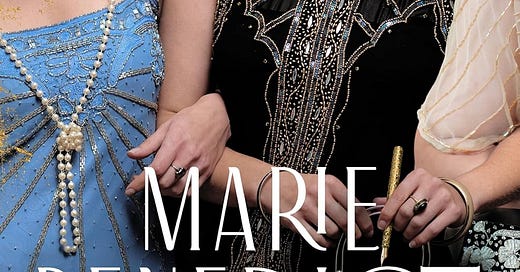The Queens of Crime by Marie Benedict (St. Martin’s Press, 2025).
The Four Queens of Crime by Rosanne Limoncelli (Crooked Lane Books, 2025).
In one of those crazy coincidences that occur every now and then in the world of books, films, and plays, two different authors have just brought out novels about the great female Golden Age mystery novelists. Even their titles are almost the same! The Four Queens of Crime by Rosanne Limoncelli focuses on Dorothy L. Sayers, Agatha Christie, Margery Allingham, and Ngaio Marsh; Marie Benedict’s The Queens of Crime deals with all these plus Baroness Emma Orczy, author of The Scarlet Pimpernel.
As many of you know, Sayers is one of my all-time favorite writers (I even wrote my own book about her), and I’m a fan of the rest of these Golden Age novelists as well. So I had to pick up both these books, which depict these writers as crime-solvers in their own right.
Benedict sets her novel in 1931, not long after Sayers has helped to found the Detection Club for mystery novelists (which she really did), and invited her four female colleagues to join it. Sensing a marked lack of respect from the male club members, the five women hit on the idea of solving a real mystery to show what they can do. Their opportunity comes when the body of a young English nurse is discovered in Boulogne, with a syringe nearby.
Benedict takes the bold step of using Sayers as the first-person narrator of her story. Unfortunately, it’s a risk that doesn’t pay off. Being inside Sayers’s mind, given all we know of her fierce intelligence and the personality that C. S. Lewis compared to “a high wind,” should be a dizzying experience. Here, it’s a bland one. There’s nothing of the wit or vivacity or shrewdness that should be there, just an ordinary straightforward narration of the sort that you’d get from any average character.
I know less about Christie than I do about Sayers, and I know much less than that about Allingham, Marsh, and Orczy, though I’ve read and enjoyed books by all of them. I think Benedict has done a slightly better job of capturing Christie’s more reserved personality, but I can’t speak to the rest of them. It doesn’t help matters, however, that we don’t get much characterization of any of them. So much time is spent on what everyone is wearing and eating and drinking in every scene that there’s not much room left for character development. And much of the dialogue and the narration consist of info dumps that work against characterization, rather than helping with it, since you can’t imagine anyone in real life talking or thinking like that.
Limoncelli has set her novel at the other end of the 1930s, with war looming on the horizon, and she has Sayers, Christie, Allingham, and Marsh hosting a gala to raise money for a new Women’s Voluntary Service. When Sir Henry Heathcote, the owner of the estate where the gala was held, is found dead in his study the following morning, the four detective writers find themselves assisting Detective Chief Inspectors Lilian Wyles and Richard Davidson in solving his murder.
Limoncelli’s dialogue flows a little more naturally than Benedict’s on the whole, but her descriptive prose is somewhat stiff. And she shares Benedict’s habit of making sure every one of her main characters takes turns delivering a line of dialogue in a scene, which, again, strains credulity and makes things sound artificial.
Both authors also tend to be rather vague in their references to the works of these great mystery writers. Benedict avoids specifics whenever possible, and Limoncelli makes generalizations that aren’t always accurate (like having Marsh say that Sayers’s villains are usually motivated by revenge, when in fact the majority of them have financial motives for their crimes). Limoncelli also includes inaccurate details, like repeatedly having her characters call Sayers “Mrs. Sayers.” It was Miss Sayers, or Mrs. Fleming, and Sayers in real life would not have been shy about correcting people on that point—she was known to bristle when critics forgot to use her middle initial, never mind getting her entire name wrong. Benedict, for her part, has a character ask Sayers which of various correct and incorrect forms of her name she prefers, only to have Dorothy respond, “I’ll answer to any”—which she certainly would not have done.
These may sound like small things, but to me, in conjunction with the general indistinctiveness of the personalities portrayed here, they suggest a lack of care taken with subjects who deserved better. I don’t blame anyone for wanting to write a novel about these brilliant and intriguing figures; it’s a worthwhile endeavor. But I’m afraid we’re still waiting for the novel that will do them justice.
(Cover images copyright St. Martin’s Press and Crooked Lane Books, respectively. Thanks to NetGalley for advance review copies of both books.)
Book Links:
The Queens of Crime on Amazon
The Queens of Crime on Bookshop
The Four Queens of Crime on Amazon
The Four Queens of Crime on Bookshop
(Note: As an Amazon Associate I earn from qualified purchases.)
Goodreads Reviews:
American Housewife by Anita Abriel




